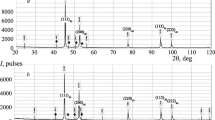Abstract
The effects of die heating and stress-relief temperatures in reducing residual stresses of squeeze-cast aluminum alloy rods are experimentally determined by the longitudinal slitting method, and their reduction effects on the mechanical properties of the squeeze-cast alloy rods are investigated. Stress relief is much more effective than die heating in reducing residual stresses of the squeeze-cast alloy. Stress relief is substantially completed at 350 ° in 1 h, but at the expense of reduction in strength and hardness. Appreciable reduction in strength and hardness is avoided by using a stress-relief temperature of 250 ° for residual stress reduction of squeeze-cast aluminum alloy. Die heating to a maximum of 200 ° is considered adequate to substantially reduce the chilling effect of the metal mold on the solidifying molten metal and to avoid appreciable reduction of strength and hardness resulting from die heating effects.
Similar content being viewed by others
References
S. Chatterjee and A.A. Das, Effects of Pressure on the Solidification of Some Commercially Al-Base Casting Alloys,Inst. Br. Foundryman, Vol LXV, 1972, p 420–429
S. Chatterjee and A.A. Das, Some Observations on the Effect of Pressure on the Solidification of Al-Si Eutectic Alloys,Inst. Br. Foundryman, Vol LXVI, 1973, p 118–124
A.A. Das and S. Chatterjee, Squeeze Casting of Aluminum Alloy Containing Small Amounts of Silicon Carbide Whiskers,Metall. Mater. Sci., March 1981, p 137–158
J.R. Franklin and A.A. Das, Squeeze Casting—A Review of the Status,Metall. Mater. Sci., March 1983, p 150–158
M.S. Abifarin and M.B. Adeyemi, Residual Stresses in Squeeze Cast Aluminium Rods,Exp. Mech., Vol 33 (No. 3), Sept 1993, p 174–180
D.J. Huang, W.E. Mayo, and Y. Chen, Residual Stress Measurement in Time Controlled Quenched Austenitic Stainless Steel,Exp. Mech., Vol 28 (No. 4), Dec 1988, p 359–363
M.B. Adeyemi, R.A. Stark, and G.F. Modlen, Isothermal Stress Relief of Cold-Extruded Mild Steel Rods,Heat Treatment, Conf. Proceeding (Birmingham), TMS/AIME, 1979, p 122–125
L.W. Crane, Origins, Effects and Removal of Residual Stresses,Heat Treatment: Methods and Media, 5th Annual Conference Papers (Birmingham), Institute of Metallurgical Technicians, July 1979, 1207-79MT, p 1-8
J.G. Tweeddale,Metallurgical Principles for Engineers, Chaple River Press Ltd., 1962
P.S. Midha and G.F. Modlen, Residual Stress Relief in Cold-Extruded Rods,Met. Technol., Nov 1976, p 529-533
M.B. Adeyemi, “Isothermal Stress Relief and Stress Relaxation of Cold-Extruded Mild Steel Rods,” Ph.D. thesis, Loughborough University of Technology, 1979
R.W.K. Honeycomb,The Plastic Deformation of Metals, Edward Arnold Ltd., 1977
J.A. Aniyi, “Effects of Die and Stress-Relief Temperatures on Squeeze Cast Commercially Pure Aluminium,” Ph.D. thesis. University of Ilorin, 1994
Author information
Authors and Affiliations
Rights and permissions
About this article
Cite this article
Aniyi, J.A., Bello-Ochende, F.L. & Adeyemi, M.B. Effects of pressure, die, and stress-relief temperatures on the residual stresses and mechanical properties of squeeze-cast aluminum rods. JMEP 5, 399–404 (1996). https://doi.org/10.1007/BF02649343
Issue Date:
DOI: https://doi.org/10.1007/BF02649343




